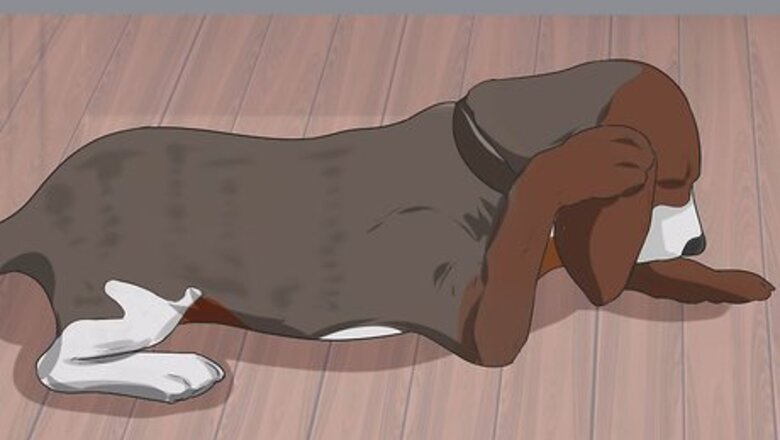
views
X
Research source
Ear infections, which have many causes (e.g., bacteria, ear mites, food allergies), can make a beagle feel itchy and miserable, and may lead to serious health problems if left untreated. If your beagle’s ears are bothering him, make sure he gets the treatment he needs as soon as possible.
Recognizing an Ear Infection in Your Beagle
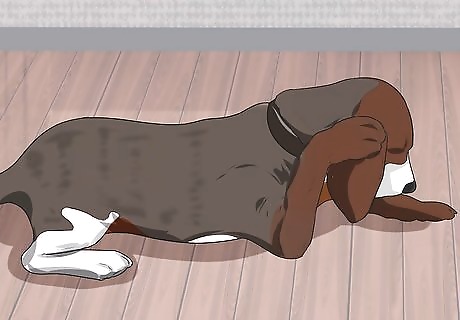
Observe your beagle’s behavior. Your beagle won’t be able to hide his ear infection. He will scratch and paw at his ears, and shake his head. In addition, he might rub his ears on nearby objects to relieve the itch. If the ear infection is really bothersome, your beagle may shake his head so much that a large blood clot, called a hematoma, forms in his ear. Your beagle may feel so miserable that he becomes withdrawn. If you try to touch your beagle’s ears, he may cry out or whine. He may even become aggressive because of how sensitive and painful his ears feel.
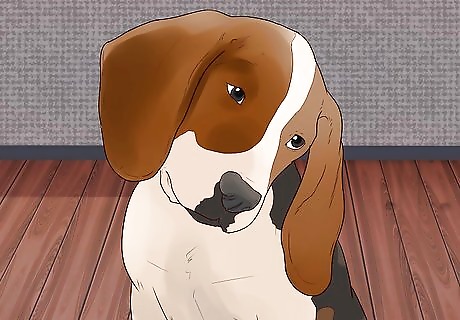
Watch how your beagle holds his head. If your beagle has a severe ear infection, he may start tilting his head down to one side or the other. The side on which he tilts his head indicates the bothersome ear. If both ears are bothering him, he may tilt his head from one side to the other.
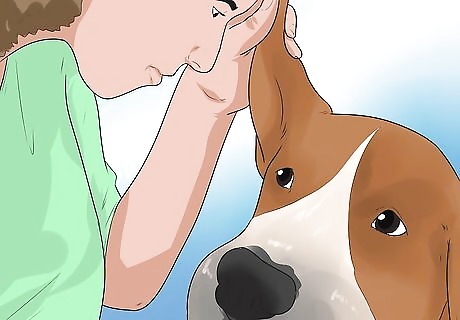
Smell your dog’s ears. Infections caused by an organism (e.g., yeast, bacteria, fungus) can make a dog’s ears smell pretty bad. If your beagle will let you, lift the flap of one ear and take a whiff. A strong, foul odor indicates an ear infection.
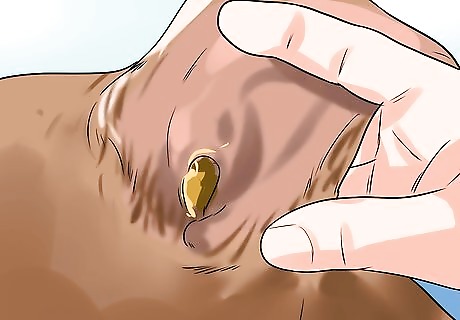
Watch for discharge coming from your beagle’s ears. Discharge is a common sign of ear infection. The discharge can be various colors, including yellow, green, or black. If your beagle has ear mites, the discharge could be very thick.
Check your beagle’s ears for mites. Mites are little parasites that can cause major irritations in a beagle’s ears. They can burrow deep in your beagle’s ear canal and cause major swelling and irritation when they bite the skin in the ear. They also reproduce very quickly, so it wouldn’t take long for your beagle to have a serious mite problem. Mites are too small to be seen with the naked eye, but you would be able to see evidence of the mites: thick red or brown crusts and dark coffee ground-like bumps.
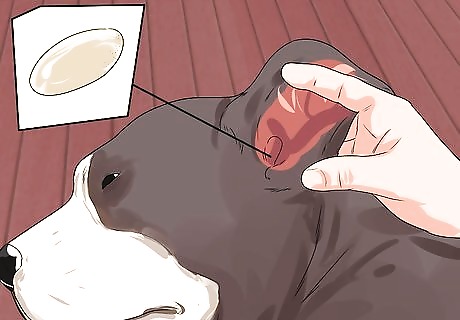
Look for a foreign object in your beagle’s ears. Sometimes, a foreign object, like a grass seed or pebble, can get stuck in your beagle’s ears and lead to an infection. If you can see the object, you can try to gently pull it out with your fingers or a pair of tweezers. If you cannot see it or pull it out, leave it in place and take your beagle to your vet. Realize that pulling out the foreign object will not treat the ear infection. It will just remove the source of the irritation.
Seeking Veterinary Treatment

Schedule an appointment with your vet. Ear infections in beagles need immediate care. In addition to making your beagle feel even more miserable, an untreated an ear infection could lead to permanent hearing loss and cause illness in other parts of his body.
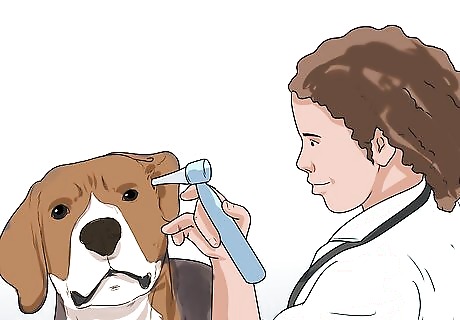
Have your vet examine your beagle’s ears. Your vet will use an instrument called an otoscope to take a closer look inside your beagle’s ears. They will also take a sample of the debris and/or discharge in his ears and look at it under the microscope. If your beagle’s ears are really painful and sensitive, your beagle would need to be sedated for the exam. Your vet will examine your beagle as a whole to identify other potential causes of the ear infection (e.g., diabetes, diseases of the immune system). Food allergies can cause chronic ear infections in dogs. If your vet suspects a food allergy, then you would need to conduct a food elimination trial with your vet’s guidance.
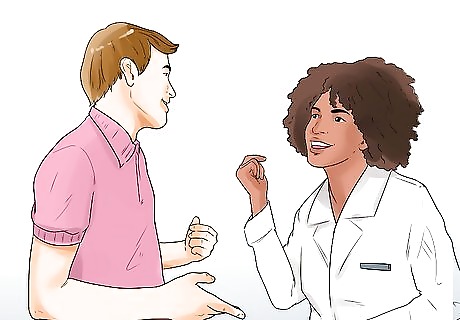
Discuss treatment options with your vet. In general, treatment for ear infections involves cleaning and medicating the ears. The type of medication needed depends on the cause of the infection (e.g., antibiotics for a bacterial infection, antifungals for a yeast infection). Steroids are used to reduce inflammation. If your beagle has a severe infection, he will need a veterinary ear cleaning. For the procedure, your vet would anesthetize your beagle, flush his ears out with a special cleaning solution and put medication in the ears. Underlying health conditions would need to be treated and/or managed along with the ear infection. If mites are causing the ear infection, your vet will prescribe a medication to kill the mites. Surgery is a ‘last resort’ option for chronic ear infections when there is so much scarring that the ear canal is nearly closed. A veterinary specialist would remove the entire ear canal. Although this procedure is expensive, it is very effective at preventing future ear infections.
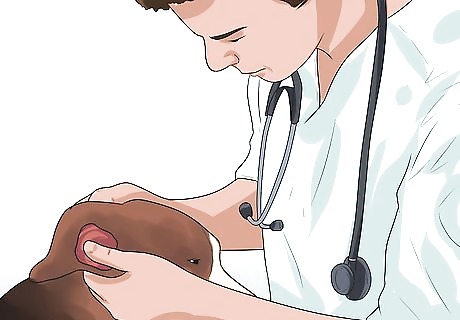
Clean and treat your beagle’s ears as prescribed. Successful treatment of your beagle’s ear infection depends on you administering the medications exactly as prescribed. When you clean his ears, apply the prescribed number of drops of ear cleaning solution into his ears, massage his ears for about 1 minute, then wipe his ears dry with some cotton balls or gauze. Don’t be surprised if your beagle shakes his head when you apply the drops—this is normal. Try not to touch the tip of the treatment bottle to his ear, since this could transfer dirt or the disease-causing organism to the bottle. If the tip touches his ear, clean it off with a clean piece of cotton ball or gauze. Over-the-counter ear cleaning solutions are available at your local pet store. Ask your vet for recommendations on which product to purchase. Treatment usually takes 3 to 7 days, but may take longer if the ear infection is severe.
Preventing Future Ear Infections
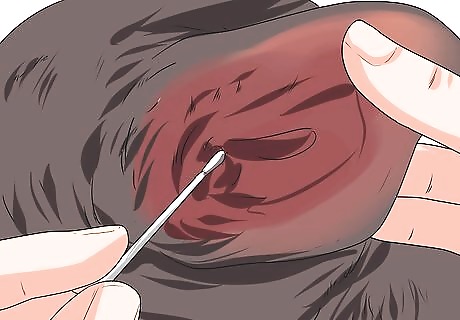
Clean your beagle’s ears regularly. Your beagle’s floppy ears are prone to reinfection, so you will need to be diligent about preventing future ear infections. One way to do this is to clean his ears at least once a week. If he has had chronic ear infections, you may need to clean his ears every day. Your vet can recommend the ideal ear cleaning frequency for your beagle. Schedule your beagle’s ear cleanings for the same day and same time each week. Be aware that regular cleanings may not completely prevent future ear infections, but will reduce their frequency. Do not use medicated ear drops after you clean his ears, even if you have some left over from his treatment. Overuse of antibiotic ear drops can lead to the growth of bacteria that is resistant to most forms of antibiotics. This can make future infections very difficult to treat.
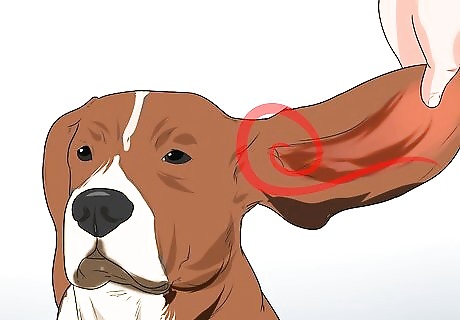
Let air flow through your beagle’s ears. Your beagle’s long and floppy ears prevent good air circulation within the ears. Without much air flow, heat and moisture can get trapped in the ears, which can lead to an infection. To increase air flow, flip his ears on top of his head so his outer ears are exposed to air. If he flips them back, use some cotton gauze and tape to secure his ears to the top of his head. When you have his hears flipped back onto the top of his head, wrap the gauze once or twice around his head. Wrap the gauze firmly, but not so tightly that your beagle is uncomfortable. The gauze is not adhesive, so you will need the tape to keep the gauze together. You do not have to leave your beagle’s ears flipped up all day—he probably wouldn’t tolerate having his ears like this for very long. Talk with your veterinarian about how long to keep his ears up in this fashion.

Change your beagle’s diet. If your beagle has a food allergy, then switching his food would be key to preventing future ear infections. Based on the results of the food elimination trial, your vet would be able to identify the ‘culprit’ ingredient. For dogs, common food culprits include beef, chicken, and dairy products. Feeding him a diet that does not contain the allergy-causing ingredient can help prevent future ear infections. Be aware that a diet with a novel protein source (a protein your beagle hasn’t eaten before) may help prevent ear infections for a while, but may not be as effective once your beagle’s digestive system becomes used to the protein. A meat-based diet that is low in yeast may help prevent yeast-based ear infections. Talk with your veterinarian before making any changes to your beagle’s diet.
















Comments
0 comment